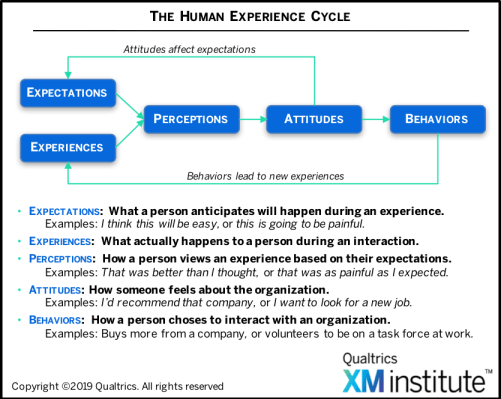One of the key building blocks of Experience Management (XM) is X-data, which helps establish an understanding of how people think, feel, and behave. In almost all circumstances, organizations lack the X-data they truly need. So how should organizations go about instrumenting their operations to collect the right data?
To identify the required X-data, it’s important to first understand how data flows from people’s experiences. That’s why you should start with the Human Experience Cycle (HxC). As you can see below, experiences lead to perceptions, attitudes, and behaviors.

Using the HxC model, we examined the components of many XM programs and have identified six distinct types of X-data:
- Experience Expectations. How people think and feel about a future interaction with an organization, which can be collected on a regular cycle or periodically (e.g., whether a customer expects a product to be hard to use or believes they can accomplish a service interaction online).
- Interaction Perceptions. Feedback on a specific interaction, which can be tracked continuously or periodically (e.g., feedback after an online purchase or after an employee training course).
- Journey Perceptions. Feedback on collection of activities around a goal, which can be tracked continuously or periodically (e.g., feedback after an airline customer finishes a trip or after an employee completes her on-boarding).
- Relationship Attitudes. How people feel about an organization, including plans for future interactions, which can be tracked on a regular cycle or periodically (e.g., NPS or brand tracking study).
- Ad-Hoc Diagnostics. How people think or feel about a problem or opportunity, which is collected as needed based on other findings (e.g., pulse employee survey about a leadership issue or qualitative study into why a brand message didn’t work).
- Choice Preferences. How people would rank different alternatives, which is collected periodically (e.g., product feature selection or employee benefits optimization).
XM programs need to collect these six types of X-data for all human beings in their ecosystem (e.g., suppliers, employees, customers, prospects, stakeholders, etc.). This effort embodies what we call the “Experience Monitoring” skill within the XM Competency of “Enlighten.”
We’ll use this taxonomy in future posts and research to help organizations assemble the right XM programs. For now, think about where you might collect and how you might use these different types of X-data.
The bottom line: Every organization needs these six types of X-data.





